Review of Flood Routing - PowerPoint PPT Presentation
1 / 32
Title:
Review of Flood Routing
Description:
Orifice at h = 0 ft. Area (6000 to 17,416 ft2) Volume ranges from ... 2S/dt Q vs Q where Q is sum of weir and orifice flow rates. Storage Indication Curve ... – PowerPoint PPT presentation
Number of Views:193
Avg rating:3.0/5.0
Title: Review of Flood Routing
1
Review of Flood Routing
- Philip B. Bedient
- Rice University
2
Lake Travis and Mansfield Dam
Lake Travis
3
Mansfield Dam, built in 1937
Lake Travis
4
Brays Bayou High Flow
6 to 7 inches of Rainfall
5
T.S. Allison June 2001
6
Houston
Galveston Bay
Hurricane Rita Landed on Sabine, TX On Sep 24,
2006
7
Storage Reservoirs - The Woodlands
8
Detention Ponds
- These ponds store and treat urban runoff and also
provide flood control for the overall
development. - Ponds constructed as amenities for the golf
course and other community centers that were
built up around them.
9
Reservoir Routing
- Reservoir acts to store water and
release through control structure later. - Inflow hydrograph
- Outflow hydrograph
- S - Q Relationship
- Outflow peaks are reduced
- Outflow timing is delayed
Max Storage
10
Inflow and Outflow
11
Inflow and Outflow
I1 I2 Q1 Q2 S2 S1
2
2
Dt
12
Inflow Outflow Day 3
change in storage / time Re Repeat for
each day in progression
13
Determining Storage
- Evaluate surface area at several different
depths - Use available topographic maps or GIS based
DEM sources (digital elevation map) - Outflow Q can be computed as function of depth
for either pipes, orifices, or weirs or
combinations
14
Typical Storage -Outflow
- Plot of Storage in acre-ft vs. Outflow in cfs
- Storage is largely a function of topography
- Outflows can be computed as function of
elevation for either pipes or weirs
Combined
S
Pipe
Q
15
Reservoir Routing
- LHS of Eqn is known
- Know S as fcn of Q
- Solve Eqn for RHS
- Solve for Q2 from S2
Repeat each time step
16
Example Pond Routing
- Note that outlet consists
- of weir and orifice.
- Weir crest at h 5.0 ft
- Orifice at h 0 ft
- Area (6000 to 17,416 ft2)
- Volume ranges from 6772 to 84006 ft3
17
Example Pond Routing
Develop Q (orifice) vs h Develop Q (weir) vs
h Develop A and Vol vs h Storage - Indication
2S/dt Q vs Q where Q is sum of weir and
orifice flow rates.
18
Storage Indication Curve
- Relates Q and storage indication, (2S / dt
Q) - Developed from topography and outlet data
- Pipe flow weir flow combine to produce Q
(out)
Only Pipe Flow
Weir Flow Begins
19
S-I Routing Results
I gt Q
Q gt I
See Excel Spreadsheet on the course web site
20
S-I Routing Results
I gt Q
Q gt I
Increased S
21
Comparisons River vs. Reservoir Routing
Level pool reservoir
River Reach
22
River Routing
River Reaches
23
River Rating Curves
- Inflow and outflow are complex
- Wedge and prism storage occurs
- Peak flow Qp greater on rise limb
- Peak storage occurs later than Qp
24
Looped Rating Curves
- Due to complex hydraulics
- Higher peak Qp on inflow
- Lower peak Qp on outflow
- Due to prism and wedge
- Red River results shown
25
Wedge and Prism Storage
- Positive wedge I gt Q
- Maximum S when I Q
- Negative wedge I lt Q
26
Muskingum Equations
- Continuity Equation I - Q dS / dt
- S K xI (1-x)Q
- Parameters are x weighting and K travel
time - x ranges from 0.2 to about 0.5 - where Cs are functions of x, K, Dt and sum to
1.0
27
Muskingum Equations
C0 ( Kx 0.5Dt) / D C1 (Kx 0.5Dt) /
D C2 (K Kx 0.5Dt) / D Where D (K Kx
0.5Dt) Repeat for Q3, Q4, Q5 and so on.
28
Muskingum River X
Select X from most linear plot
Obtain K from line slope
29
Hydraulic Shapes
- Circular pipe diameter D
- Rectangular culvert
- Trapezoidal channel
- Triangular channel
30
Storage Indication Curve
- Relates Q and storage indication, (2S / dt
Q) - Developed from topography and outlet data
- Pipe flow weir flow combine to produce Q
(out)
Only Pipe Flow
Weir Flow Begins
31
Storage Indication Inputs
Storage-Indication
32
Storage Indication Tabulation
Time 3 - Note that 65.6 - 2(17.6) 30.4 and is
repeated for each one






























